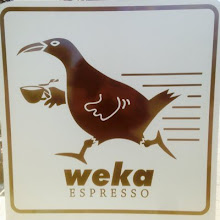Last week's wine tasting was by Moana Park of Hawkes Bay. Moana Park has been growing grapes in Puketapu (at the back of Taradale, Napier) for 40 years but only operating as a winery for the past 11 years. James the winemaker was our host and told us about the natural processes Moana Park uses to produce their wines. Their sprays are organic, as is every product they use apart from their weedkillers. Heard it all before? Here's a new fact that surprised me: Moana Park is the only commercial vegetarian winery in the southern hemisphere as they don't use animal byproducts in any part of the fermentation and wine making process. Who knew wines aren't vegetarian by default? I do now.
Onto the wine tasting. We got to sample generous servings of seven varietals and even added a couple to our 'yes' wine list.
Viognier 2014. Viognier (vee-on-yay) is a new varietal for me. Bottled just one month ago, I was pleasantly surprised at how easy it was to drink. I enjoyed the spicy, stone fruit notes and didn't mind its light lees oaking. The best New Zealand viogniers come from Gisborne and Hawkes Bay, which is something I'll watch out for in future. A 'yes' from me.
Chardonnay 2014. Not being a fan of heavily oaked chardonnays, I was once again surprised at how easily this wine went down. James says this is because they aim for oak balance, not oak dominance. It works. Sweet smelling while tasting rich and fruity, this chardonnay was only bottled two weeks ago and should cellar well, if it lasts that long. Another yes for me.
Syrah 2014. Onto the syrahs. Naturally fermented without yeast and unfiltered, the aroma of this syrah was promising but not one for me.
Merlot Malbec 2014. Predominantly merlot, this wine was far too heavy for me and I couldn't finish my sample.
Gimblett Road Syrah 2013. This syrah is a single vineyard reserve from their Gimblett Road vineyard. As with the first Estate Series syrah, the smell was good but the overall product was too heavy for me.
Merlot Cabernet Sauvignon 2013. I'd been looking forward to this sample, which is usually my favourite red wine blend. At 80% merlot, 15% cabernet and the balance of sauvignon, each varietal is fermented and barrelled separately, aged for 16 months and then blended towards the end of the process. I just couldn't get past the predominant oak. Another no for me.
Late Harvest Pinot Gris 2010. We finished the evening with a late harvest dessert wine. Not too sticky, and with 90 g of residual sugar per litre, there was more of a balance between sweetness and acidity than other stickies, but it was still too sweet for me.
Monday, 1 June 2015
Subscribe to:
Post Comments (Atom)


No comments:
Post a Comment